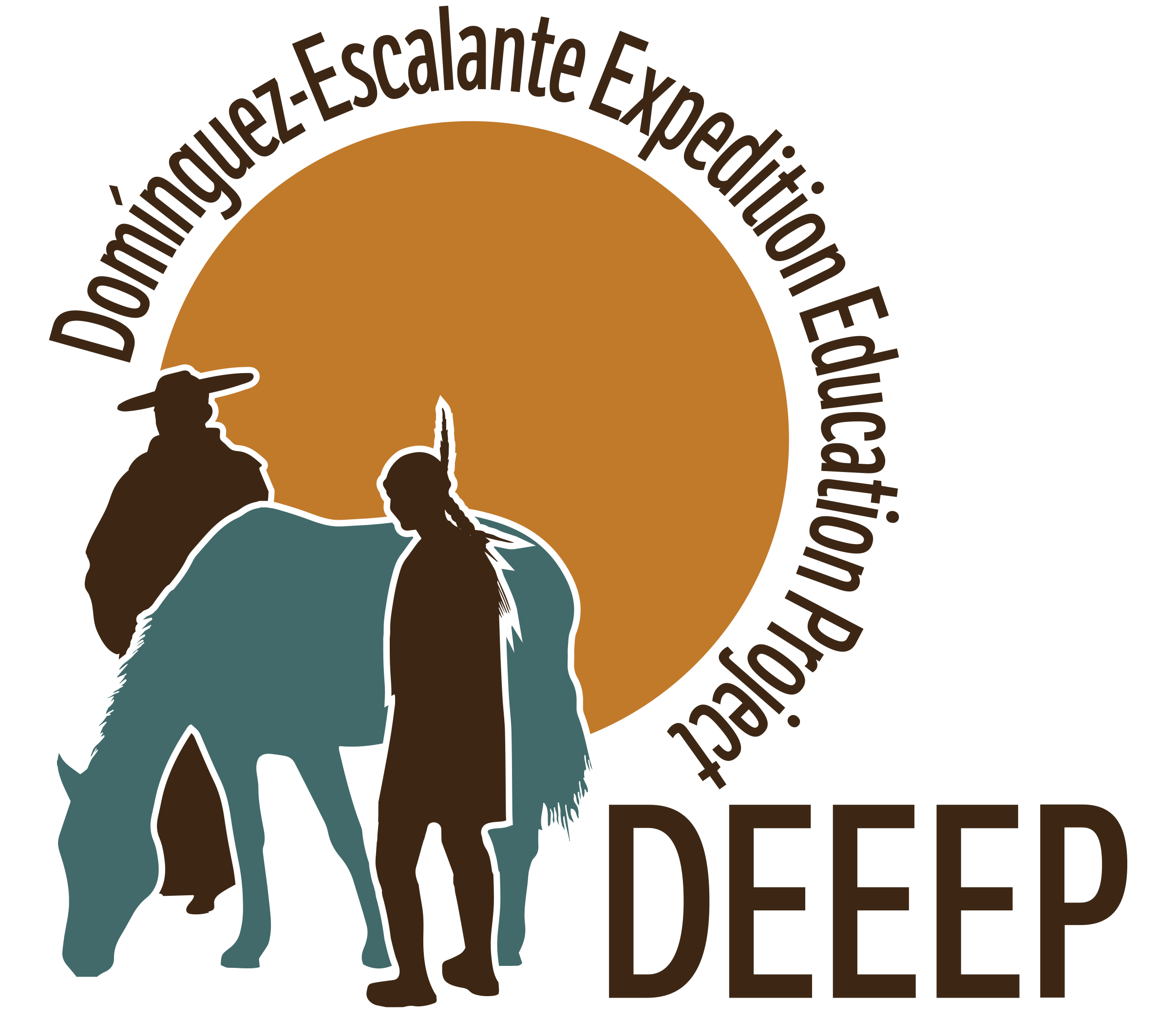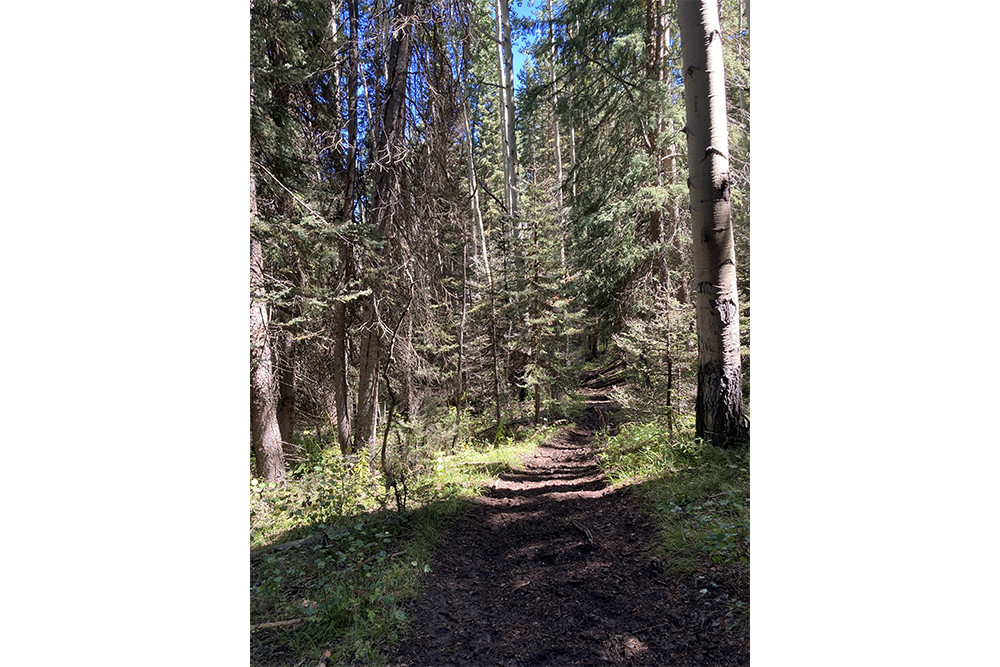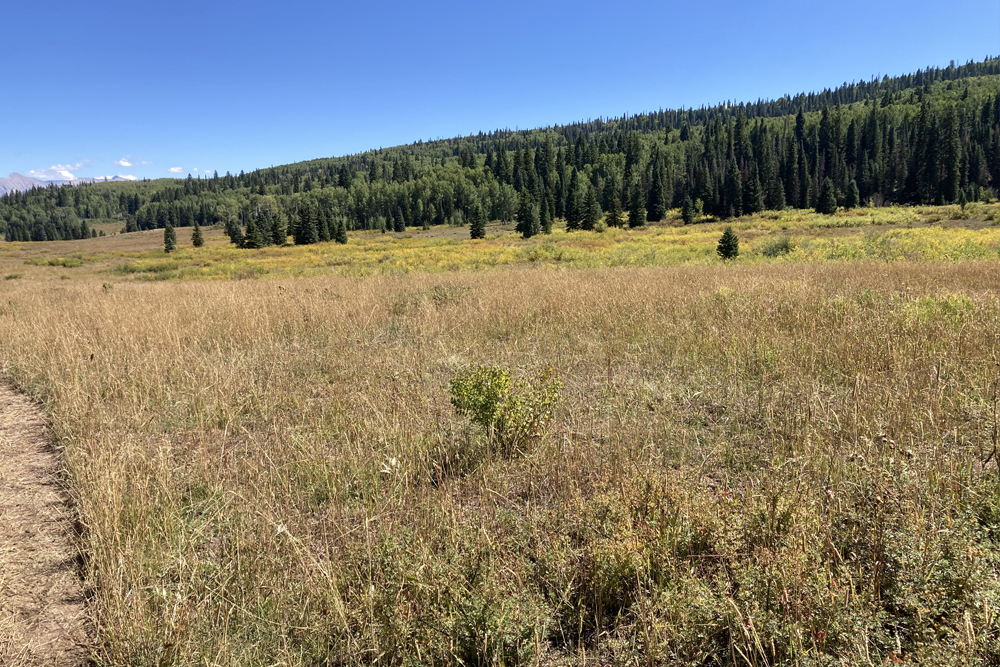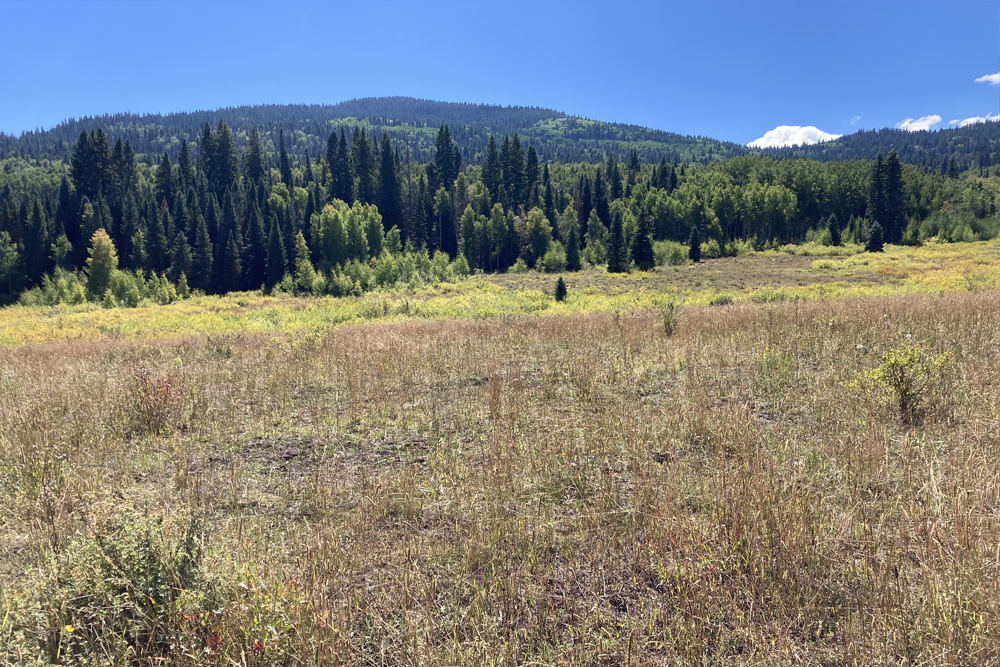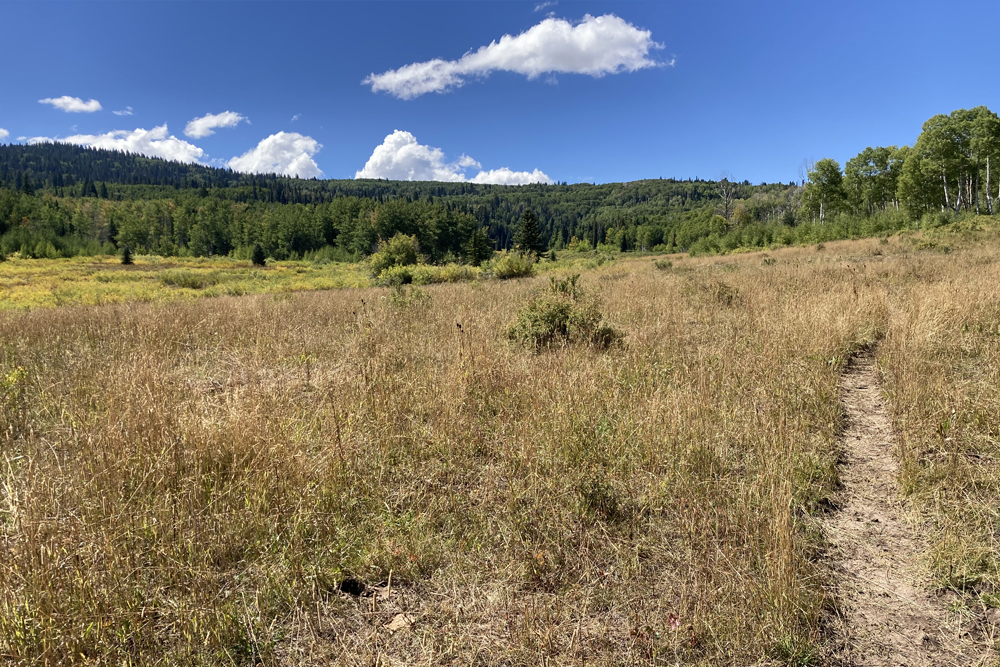September 1
Camp Name
Saint Anthony Martyr
Camp Name (Spanish)
San Antonio Mártir
Brightness of the Moon
86%
Distance Traveled
4 leagues / 10.5 miles
Daylight
13 hours / 4 minutes
Water Resources
Hubbard Creek, Fawn Creek, and Cow Creek (at campsite)
Journal Description for September 1st
On the 1st of September we set out, headed north from San Ramón, and after going three leagues through small narrow valleys of abundant pastures and thick clumps of scruboak143The party left San Ramon Nonato and ascended Hubbard Creek into Hubbard Park. They encountered the eighty Utes near the present site of the Electronic Mountain Hunting Lodge in the north extremity of the part on Electric Mountain on present Grand Mesa.we came upon eighty Yutas, all on good horses and most of them from the encampment to which we were going. They told us that they were going out to hunt, but we figured that they came together like this, either to show off their strength in numbers or to find out if any other Spanish people were coming behind us or if we came alone; for, since they knew from the night before that we were going to their encampment, it was unnatural for almost all of its men to come out at the very time that they knew we were to arrive, unless motivated by what we have just said.
We kept on going with only the Laguna, descended a very steep incline, and came into a very pleasant narrow valley, in which there was a small river144In those days Cow Creek was probably much larger because Overland Reservoir did not impound its waters. and all along its bank a spreading grove of spruces, very tall and straight, among them certain poplars which seem to ape the erectness and height of the pines. Through this narrow valley we traveled eastward for a league and reached the encampment, which had numerous people and must have consisted of thirty tents. We stopped a mile down from it by the edge of the river mentioned, naming the site San Antonio Mártir.145This campsite is located where Fawn Creek enters Cow Creek at the 8,600-foot elevation. Today four leagues146Ten and a half miles.—199 [in all].147According to their calculations, they had journeyed over 523 miles since July 29.
As soon as we halted, Padre Fray Francisco Atanasio went on to the encampment with Andrés the interpreter to see the chieftain and the others who had remained. He went into the chieftain’s tent and, after greeting and embracing him and his children, asked him to gather there the people who were on hand. He did so, and when those of either sex who could attend had been assembled, he announced the Gospel to them through the interpreter. All listened with pleasure, and especially six Lagunas who were present, among whom our guide and another Laguna stood out. As soon as the padre began instructing them, the new guide mentioned interrupted them so as to predispose the Sabuaganas as well as his own fellow tribesmen “to believe whatever the padre was telling them because it all was true.” In the same way, the other Laguna relayed the pleasure and eagerness with which he heard the news of his eternal salvation.
Among those listening there was one a bit deaf who, not grasping what was being treated, asked what it was the padre was saying. Then this Laguna said: “The padre says that this which he shows us” — it was the image of Christ crucified — “is the one Lord of all, who dwells in the highest part of the skies, and in order to please Him and go to Him one has to be baptized and must beg His forgiveness.” He emphasized this idea by beating his breast with his hand — a surprising gesture on his part for his never having seen it made before, either by the padre or by the interpreter. When the padre saw the evident joy with which they heard him, he suggested to the chieftain now in charge of the encampment that if, after he had conferred with his people, they would accept Christianity we would come to instruct them and set them in a way of living that would lead to baptism. He replied that he would propose it to his people, but he did not return all afternoon to provide further cause whereon to base a likely hope of their accepting the proposal.
Filled with joy by the open declaration of the Lagunas mentioned, the padre asked how the latter one was called (the guide we had already named Silvestre),148Silvestre would guide the party to present Utah Valley and Utah Lake. The debt to this Indian guide as well as to others engaged along the trail was considerable. Silvestre knew the trail well and thus prevented the padres from making misjudgments as to the route to be followed. and on learning that they called him Red Bear he instructed them all by explaining to them the difference existing between men and brutes, the purpose for which either of them were created, and the wrong thing they did in naming themselves after wild beasts — thus placing themselves on a par with them, and even below them. Promptly he told the Laguna to call himself Francisco from then on. When the rest saw this, they began repeating this name, although with difficulty, the Laguna joyfully pleased for being so named.
It also happened that when the padre addressed as chief the one who, as already said, was in charge of the encampment, he replied that he was not it and that the real chief was a fine-looking youth who was present; and when the padre asked him if he [the youth] was married, he answered that he was and that he had two wives. This embarrassed the said youth (whom the other had done the honor of pointing out for his being the brother of a greatly revered chieftain among the Sabuaganas named Yamputzi), and he tried to make out that he had only one wife. From this it can be inferred that these barbarians are aware or cognizant of the repugnance inherent in having multiple wives at one and the same time. From here the padre grasped the opportunity to instruct them on this point, and to exhort them not to have more than one.
When this was all over, some jerked bison meat was bought from them, they being paid for it with white beads, and they were asked if they wanted to exchange some horses for other now hoofsore ones that we brought along. They replied that they would exchange them later in the afternoon. This done, the padre came back to the king’s camp.149The diarists used the word real or “king’s camp” to refer to their campsites in order to differentiate from the camps or encampments of Indians encountered along the trail. To understand why they used the term real it is necessary to put oneself in their shoes and see things as they saw them. They believed they were in fact representing the king on this expedition and would therefore refer to their campsites as literally “the king’s camp.”
A little before sundown the chief, some very old men, and many of the others came to where we were. They began trying to persuade us to turn back from here, exaggerating anew and with greater effort the hardships and perils to which we were exposing ourselves by going ahead, saying for certain that the Comanches would not let us do so — and that they did not tell us this to stop us from going as far as we wanted, but because they esteemed us highly. We acknowledged this token and told them that the one God whom we worshiped would expedite everything for us and would defend us, not only from the Comanches but also from all others who might intend to do us harm, and that we feared not a thing of what they were bringing up because we were certain that His Majesty was on our side.
Seeing that their pretexts were of no avail, they said that since we wished to go ahead without paying heed to what they warned us about we should write to the great chief of the Spaniards (thus they call the lord governor), telling him that we passed through their country, so that, in the event that we had some mishap and did not return, the Spaniards would not think that they had taken our lives. This was a ruse from among some of our own companions, who wanted to turn back or loiter among them. We answered them that we would write to him, and would leave them the letter for the day one of them went to New Mexico and took it along. They replied that they did not offer to take it, that we should send it by one of our own. We told them that none of these could go back or stay among them. Finally, now that they found no other way to hinder our passage without declaring themselves our enemies, they said that if we did not turn back from here they would not make exchanges for the hoofsore horses we had; to this we replied that we would go on even if they made no exchange, because under no circumstances would we turn back without knowing the whereabouts of the padre our brother who had been among the Moquis and Cosninas and might be wandering about lost.
To this they replied, prompted by those of our very own who understood their language and were underhandedly giving us a rough time, that the padres could not get lost because they carried drawn on paper all the lands and routes of travel. They began pressing again, by rehashing all that has been related about our turning back from here. Then, on seeing our unshakeable determination, they repeated that they were urging us not to go ahead because they loved us, but that if we wished to do so they were not stopping us and that in the morning they would exchange the horses. They took their leave well after nightfall, not without hope of overcoming our determination next day, for, as we came to find out, they were assured of it by Felipe — the one from Abiquiú — Andrés the interpreter, and his brother Lucrecio, they being the ones who, either out of fear or because they did not want to go ahead, were secretly prompting the Sabuaganas ever since they learned that they were opposed to our plans.150Fathers Domínguez and Escalante will have further trouble with these men. This caused us much grief and very much also what follows.
Ever since La Villa de Santa Fe, we had reminded all of the companions that those who wished to be part of this expedition were not to take along any goods for trading and that those who did not agree to this condition were to stay behind. All agreed not to bring a thing, nor any purpose other than the one we had, which was God’s glory and the good of souls. For this reason, everything that they requested for their equipment and to leave to their families was rationed out to them. But some of them failed in their promise by secretly carrying some goods we did not see until we were near to the Sabuaganas. And here we charged and begged them all not to engage in commerce, so that the infidels might understand that another motive higher than this one brought us through these parts.
We had just been telling the Sabuaganas that we needed neither arms nor men because we placed all our safety and defense in God’s almighty arm, and Andrés our interpreter, with his brother Lucrecio, proved themselves to be such obedient and faithful Christians151No doubt meant sarcastically. that they peddled what they secretly brought along and most greedily sought weapons from the infidels, telling them that they badly needed them because they were about to pass through the lands of the Comanches. In this way, to our own sorrow, they betrayed their meager faith or lack of it, and how very unfit they were for ventures of this kind.
Notable Event
This was a long journal entry, reflecting the extensive interactions the expedition had with the Ute Indians. The expedition continued traveling northward climbing further up on La Sierra del Venado Alazán (the Grand Mesa). There they first encountered a group of 80 Ute warriors on horseback, then later they reached the encampment of Ute Indians that Escalante described as consisting of numerous people and 30 tents (teepees).
After establishing a camp, Domínguez with the interpreter, Andrés Muñiz, returned to the Indian encampment and preached the gospel to the residents of the camp. A little before sundown a group of old men and other came to the Spaniards camp. There was a long discussion with the Utes trying to convince the Spaniards to abandon their journey due to the dangers involved in traveling further, especially from the Comanche Indians who were supposedly to the north of their current location. These discussions and arguments would continue into the next day.
Escalante also describes a problem that developed with some of their expedition crew members. The expedition members were not supposed to bring any trade goods on the expedition, so that the focus of the expedition would only be “God’s glory and the good of souls.” The two members mentioned were the interpreter Andrés Muñiz, with his brother Lucrecio Muñiz. Escalante does not describe what discipline, if any, was given to the two members. But the leaders will have further trouble with these two members.
Miller Report Summary
The expedition was now ascending the Grand Mesa in search of the Indian camps. Their efforts were rewarded the following day as they continued up Hubbard Creek into present Hubbard Park where they encountered “eighty Yutas, all on good horses and most of them from the encampment to which we were going.” After this meeting the padres continued on to present Cow Creek, followed it eastward for a couple of miles to an excellent campsite at the confluence of Fawn and Cow creeks. This September 1 camp was at an 8,600-foot elevation. Nearby was the long-sought Ute camp of some 30 tents. Father Dominguez and interpreter Muniz went at once into the Indian camp to explain the objectives of the expedition, to preach Christianity to the natives, and to convince them that the purpose of the company was entirely peaceful. The conference lasted until dark, September 1.DEEEP’s Field Notes
Copyright © 2024, DEEEP Colorado. All Rights Reserved.
September 1, 1776
By DEEEP Team Members
This route and campsite also gave us some difficulty, especially locating the two campsites. From the San Ramón Nonato (Grouse Spring) Campsite, we believe the expedition traveled northward through the scattered parks and oakbrush until they hit Hubbard Creek, which they followed up into Hubbard Park. They traveled north through the park until they reached the northeast corner, near where Electric Mountain Lodge is located. Here they met the group of 80 Ute warriors. Other than starting out from Grouse Spring, instead of the site identified by the Miller team – the meadow 1 mile north of the confluence of Hubbard Creek and Willow Creek, our assessment of the route follows the route identified by those researchers. It is in the next section where we believe there are some differences.
We believe the expedition rode out of the northeast corner of Hubbard Park, following a trail that drops 1,000 feet down to Fawn Park. We believe the Indian camp was located in the north-central part of Fawn Park. This area has all the requirements for a large encampment – a large, flat area that would allow for 30 teepees, water in Fawn Creek and forage for a large number of horses. The area described by the Miller team will not allow for camping. Where Fawn Creek joins Cow Creek the drainage is very narrow and incised and barely allows for a trail along Cow Creek. The campsite used by the D-E expedition might be located along Cow Creek to the east of the Fawn Creek and Cow Creek confluence. I drove up to Electric Mountain Lodge and hiked to the area I believe is the Fawn Creek Indian campsite. I believe the Indian Camp was located in T.11S., R.91W., NE¼SE¼ S.16, 6th P.M. or 39°06’1” N, 107°33’17” W. Elevation 8,700 feet. I did not make it to the D-E campsite. But looking at the County GIS maps we believe it may have been located at nearly 1 mile below the Indian Camp in T.11S., R.91W., SW¼NW¼ S.15, 6th P.M. or 39°06’01” N, 107°32’53”. Elevation 8,600 feet. This area matches Escalante’s description in the journal. And it does not differ greatly from the location described in the Miller Report. The distance from Grouse Spring to the San Antonio Mártir Campsite on Cow Creek following this route is 10½ miles, as measured with the measuring tool on the Delta County GIS website. The site is located on the Gunnison National Forest.
